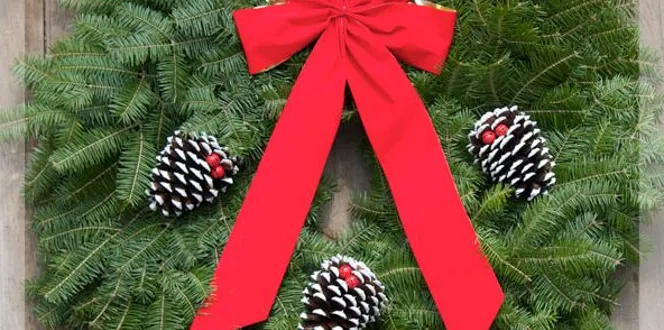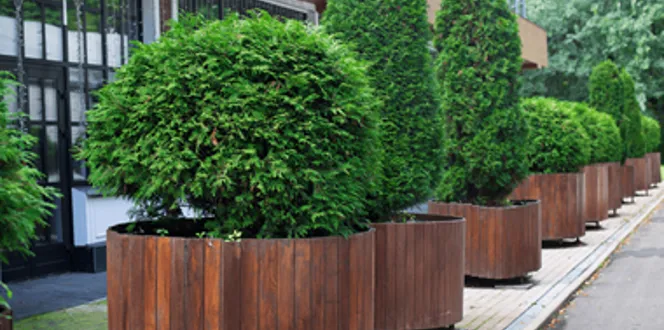As you admire the trees in your landscape, you may be wondering why some trees keep their leaves and stay green all year long, while other trees lose their leaves and go dormant.
This is a natural curiosity. The deep greens of those evergreens like pines, hemlocks, spruces, and cedars add color to the winter landscape, and even a touch of magic when covered with a layer of snow.
And then the deciduous trees that come in all shapes and sizes and provide different colors and leaf shapes lose their leaves to reveal their beautiful brown bones in the form of twisting trunks and branches.
The two together create a great visual mix from season to season in your overall landscape.
But what’s the difference? And why are there some trees that stay green and some trees that don’t? Let’s dig into the science to learn more.
Do Evergreen And Deciduous Trees Stay Green All Year?
When selecting trees for your landscape, there are generally two types to choose from: deciduous trees and evergreen trees.
Each of these trees have different life cycles. But both tree types use energy from sunlight and water to turn carbon dioxide into a sort of food. The process is called photosynthesis.
So, naturally, as the days get shorter in fall and winter, there is less of the sun’s energy to use.
But why do evergreen trees remain green all year? Let’s take a look at the main differences between evergreens and deciduous trees.
What Is The Difference Between Deciduous And Evergreen Trees?
So when that sun starts to disappear for more and more hours each day, deciduous trees go through a transformation. Do deciduous trees stay green all year? The answer is no. The location where the leaves are attached to the branch begins to seal off, depriving the leaves of nutrients and water. . And that’s what makes their leaves drop off after putting on a pretty spectacular autumn show of vibrant reds, yellows, and oranges.
But why do evergreen trees remain green all year? Evergreens have very strong leaves that are rolled up as long, thin needles. This special needle shape, along with a waxy coating, allows the evergreens to conserve water during summer and winter, which is needed for that continued photosynthesis process. So because they can conserve more water than their deciduous counterparts, their leaves stay green and remain attached longer.
Do Evergreen Trees Shed Their Leaves?
If you notice your evergreens shedding their needles, there’s no need for alarm. While it doesn’t always happen every year, it does happen, and it’s nothing to worry about. (needle shed may occur on an annual basis)
Evergreens shedding needles happens mostly in the spring. But this goes largely unnoticed because they are growing new leaves at the same time as they shed their old ones.
What Evergreen Tree Loses Its Needles?
While most conifers are evergreens, some lose more of their needles than others in the fall. And some cypress species even drop needles during the dry season as drought protection
These are the most common conifers that lose their needles and how often:
- White pine: 2 to 3 years
- Ponderosa pine: 3 years
- Scotch pine: 2 to 4 years
- Austrian pine: 4 years
- Mugo pine: 5 years
While most evergreens follow these rules, there are always exceptions. The bald cypress, for instance, loses all of its needles every year. Just like their deciduous counterparts, this acts as winter protection, enabling them to conserve resources and grow under challenging conditions.
Will Evergreen Needles Grow Back?
Though pines and most other conifers are called evergreens, their needles do not stay alive (and green) forever. The trees produce new needles every spring and summer that last for two to four or more years. Newer needles are always at the branch ends, while older needles are typically further back.
But when do pine trees shed needles? As needles age, they conduct less photosynthesis for the tree. In addition, they become shaded by new needles. That’s when they finally turn brown and drop off. New needles in most instances are there to replace the old ones. Though this can seem alarming, it’s actually a natural process and doesn’t hurt the tree. On some evergreens, like spruce or fir trees, this process is barely noticeable, while on other trees like white pines, the yellowing inner needles are easier to see beyond the green needles.
How To Tell If An Evergreen Is Dying?
If one-third to one-fourth of the needles on the inner parts of your evergreen fall off, this is usually a normal sign of aging. Leaving those needles where they fall under the tree can also a good mulch layer.
But if you notice that your beloved evergreen is losing needles at the branch tips, this could be a sign of trouble. These are young needles that haven’t had a chance to do their jobs yet. The problem could be linked to a tree insect or disease, so this is a good time to call your tree care professional so he or she can check the condition of your evergreen and make sure it’s still healthy and growing strong.
Best Evergreen Trees
Looking to add more evergreens to your landscape? You’re not alone. Most people love the mix of deciduous trees that deliver different shapes and flowers, along with those classic evergreens that deliver solid annual color.
But figuring out which ones you want to add to your yard can be challenging. Maybe you want year-round privacy that has a softer and more natural appearance than a fence. Here are the best evergreen trees you can pick for your landscape to add beauty, a natural screen, and texture to your yard.
- Concolor Fir -- Great for hot, dry conditions with blue-gray needles; can grow to 70 feet tall in zones 3 through 7
- Douglas Fir -- Loves full sun, can grow up to 80 feet tall in zones 5 through 7
- Eastern Arborvitae -- Most popular variety for screening; can grow to 70 feet tall in zones 2 through 7
- Eastern Red Cedar -- Adaptable in full sun, can grow up to 50 feet tall in zones 2 through 9
- Eastern White Pine -- Quickly grows in full sun or partial shade can grow to 80 feet tall in zones 3 through 8
- False Cypress -- Great privacy tree in colors ranging from blue-gray to golden-green; can grow to 75 feet tall in zones 4 through 8
- Leyland Cypress -- Feathery, blue-green foliage that’s a natural screen; can grow to 70 feet tall in zones 6 through 9
- Norway Spruce -- Pyramidal shape with gracefully hanging stems that grow off upward-pointing branches; can grow to 60 feet tall in zones 2 through 7
- Yew -- Bird-attracting hedge with dark green foliage and red berries; can grow to 50 feet tall in zones 4 through 7
Remember to match the right evergreen to your space. This will save you time and money in the long run and ensure the tree provides you with many years of enjoyment. And then taking care of your evergreens with proper care and fertilization can help them continue to thrive.







